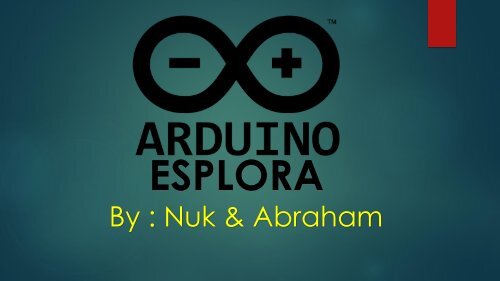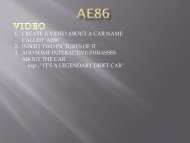Project 2 (Esplora)
You also want an ePaper? Increase the reach of your titles
YUMPU automatically turns print PDFs into web optimized ePapers that Google loves.
ESPLORA<br />
By : Nuk & Abraham
What is Arduino <strong>Esplora</strong><br />
<br />
<br />
<br />
<br />
<br />
Arduino <strong>Esplora</strong> is a microcontroller board derived from the Arduino<br />
Leonardo.<br />
The <strong>Esplora</strong> differs from all preceding Arduino boards in that it<br />
provides a number of built-in, ready-to-use set of onboard sensors<br />
for interaction.<br />
It's designed for people who want to get up and running with<br />
Arduino without having to learn about the electronics first.<br />
The <strong>Esplora</strong> has onboard sound and light outputs, and several input<br />
sensors, including a joystick, a slider, a temperature sensor, an<br />
accelerometer, a microphone, and a light sensor.<br />
It also has the potential to expand its capabilities with two Tinkerkit<br />
input and output connectors, and a socket for a color TFT LCD<br />
screen.
Arduino <strong>Esplora</strong><br />
Specifications<br />
1. Microcontroller : ATmega32u4<br />
2. Operating Voltage : 5V<br />
3. Flash Memory : 32KB of which 4KB used by bootloader<br />
4. SRAM : 2.5 KB<br />
5. EEPROM : 1KB<br />
6. Clock Speed : 16MHz<br />
7. Length : 164.04mm<br />
8. Width : 60mm<br />
9. Weight : 53 gram
Programming<br />
<br />
<br />
<br />
<br />
The <strong>Esplora</strong> can be programmed with the Arduino software<br />
The ATmega32U4 on the Arduino <strong>Esplora</strong> comes preburned with a<br />
bootloader that allows you to upload new code to it without the use<br />
of an external hardware programmer.<br />
It communicates using the AVR109 protocol.<br />
You can also bypass the bootloader and program the<br />
microcontroller through the ICSP (In-Circuit Serial Programming)<br />
header.
Characteristics<br />
The maximum length and width of the <strong>Esplora</strong> PCB are 6.5 and 2.4<br />
inches respectively, with the USB and TinkerKit connectors extending<br />
beyond the latter dimension.<br />
<br />
Four screw holes allow the board to be attached to a surface or<br />
case.
Communication<br />
<br />
<br />
<br />
<br />
<br />
The <strong>Esplora</strong> has a number of facilities for communicating with a<br />
computer, another Arduino, or other microcontrollers.<br />
The ATmega32U4 provides serial (CDC) communication over USB<br />
and appears as a virtual com port to software on the computer.<br />
The chip also acts as a full speed USB 2.0 device, using standard USB<br />
COM drivers.<br />
The Arduino software includes a serial monitor which allows simple<br />
textual data to be sent to and from the Arduino board.<br />
The RX and TX LEDs on the board will flash when data is being<br />
transmitted via the USB connection to the computer.
USB Overcurrent Protection<br />
<br />
<br />
<br />
The <strong>Esplora</strong> has a resettable polyfuse that protects your computer's<br />
USB ports from shorts and overcurrent.<br />
Although most computers provide their own internal protection, the<br />
fuse provides an extra layer of protection.<br />
If more than 500 mA is applied to the USB port, the fuse will<br />
automatically break the connection until the short or overload is<br />
removed.
A Video of Arduino <strong>Esplora</strong><br />
(SCAN IMAGE WITH HP REVEAL TO SEE THE VIDEO)
Conclusion<br />
As the conclusion,the whole idea of this arduino is to help new users learn to<br />
code in the arduino environment with lots of feedback from the imbedded<br />
features,and without needing to construct everything that would give<br />
feedback to the learner on breadboards first.



